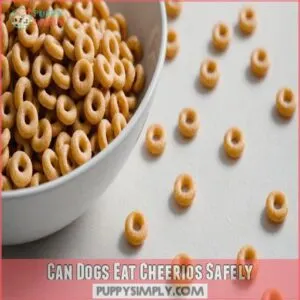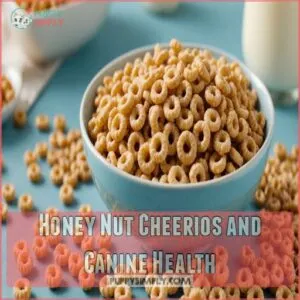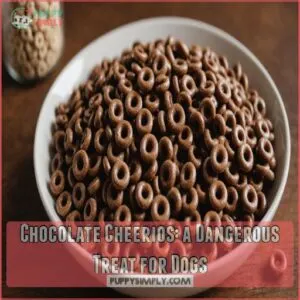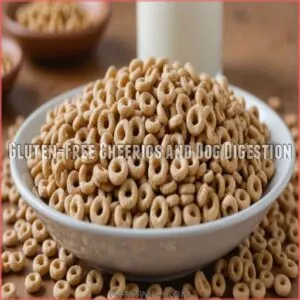This site is supported by our readers. We may earn a commission, at no cost to you, if you purchase through links.
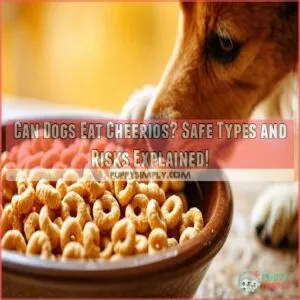 Wondering if dogs can eat Cheerios?
Wondering if dogs can eat Cheerios?
Well, they won’t harm Fido, but they’re no doggy superfood either.
Cheerios, mostly made of whole-grain oats, offer little nutritional value, like seeing a sneeze guard at an all-you-can-eat buffet!
Cereals like Lucky Charms, which contain high sugar and artificial ingredients, can be detrimental to a dog’s health. These cereal treats are empty calories compared to a dog’s high-energy needed diet.
Plain Cheerios are okay in small amounts, but sugary or chocolate varieties should be avoided—unless you want to see some tail-spinning drama.
Always remember, though they’re not toxic, they’re not exactly the bone of contention in your pup’s diet.
Curious about which types are actually safe? Read on!
Table Of Contents
- Key Takeaways
- Can Dogs Eat Cheerios Safely
- Types of Cheerios Suitable for Dogs
- Risks
- Frequently Asked Questions (FAQs)
- Can dogs eat Cheerios?
- Is it safe to eat fresh cherries?
- Can dogs eat Cheerios with pancreatitis?
- What happens if a dog eats too many Cheerios?
- Are Cheerio treats bad for dogs?
- Can dogs eat Honey Nut Cheerios?
- Is it safe for dogs to eat cheerios?
- What cereals are safe for dogs?
- Can you use cheerios as training treats?
- Are honey nut cheerios healthy?
- How often can dogs eat Cheerios?
- Are Cheerios a healthy treat for puppies?
- What is the nutritional value of Cheerios for dogs?
- Can Cheerios replace dog treats completely?
- Are there better cereal alternatives for dogs?
- Conclusion
Key Takeaways
- You can give your dog plain Cheerios in moderation, but don’t rely on them as a nutritional substitute.
- Avoid flavors like Honey Nut and Chocolate Cheerios due to high sugar and potential toxicity risks.
- Cheerios are mostly empty calories for dogs, lacking essential nutrients they need for a balanced diet.
- Consider plain Cheerios as occasional treats or training rewards, but ensure they’re less than 10% of your dog’s daily intake.
Can Dogs Eat Cheerios Safely
You might wonder if slipping your furry friend a few Cheerios is a good idea.
They can munch on these little o’s safely in moderation, but be careful not to make it a habit!
Nutritional Value of Cheerios for Canines
So, you’re wondering about Cheerios and your dog’s nutrition?
A few plain Cheerios won’t hurt, but they aren’t a replacement for dog food.
They offer minimal vitamins, and too many could lead to weight gain.
If you’re considering incorporating Cheerios into your dog’s diet, you can find more information on [Cheerios dog food products](https://zon.everysimply.com/Cheerios+dog+food/dp/restoviebel03-20/
Types of Cheerios and Their Impact on Dogs
Cheerios, beyond their familiar breakfast role, can be occasional dog treats.
However, not all types are safe.
Here’s a quick guide when considering Cheerios for Fido:
- Plain Cheerios: Low sugar content; safe in moderation.
- Honey Nut: High sugar; not recommended.
- Chocolate: Avoid completely; toxic to dogs.
- Gluten-Free: Check ingredients; safe in small amounts.
Plain Cheerios Vs. Flavored Varieties
You’ve checked which types of Cheerios are safe for dogs—now it’s plain versus flavored.
Plain Cheerios are generally the safer choice, low in sugar content and simpler in ingredients.
Flavored varieties, like chocolate, are off-limits due to potential toxicity.
Always keep serving size tiny, as Cheerios aren’t meant to replace dog food, just a treat for good behavior!
Types of Cheerios Suitable for Dogs
When considering which Cheerios varieties are safe for your furry friend, plain Cheerios are a great option in moderation.
Flavored types like Honey Nut Cheerios might smell tempting but they come with extra sugars that aren’t ideal for dogs.
Honey Nut Cheerios and Canine Health
While Cheerios can be a healthy alternative for dogs as an occasional reward or training aid, containing essential vitamins and minerals like fiber, calcium, and iron from plain cheerios benefits. Honey Nut Cheerios might seem tempting as a dog treat, they aren’t the safest choice for our furry friends.
Dogs may also face pancreatitis risks due to high-fat foods like those that include almonds for dogs. The sugar content and almond toxicity levels pose risks, making them unsuitable.
Instead, consider these healthier alternatives for your dog:
- Carrot sticks
- Plain Cheerios
- Apple slices
- Sweet potato treats
- Blueberries
Pet safety always comes first!
Chocolate Cheerios: a Dangerous Treat for Dogs
Switching from the sugary world of Honey Nut Cheerios, let’s talk danger—Chocolate Cheerios. They’re not just another cereal; they’re a toxic hazard for your dog.
Chocolate contains theobromine, which can wreak havoc on canine health.
Picture your dog as a detective, always sniffing trouble, but Chocolate Cheerios aren’t a safe snack.
Choose alternative treats to guarantee pet safety.
Gluten-Free Cheerios and Dog Digestion
Chocolate Cheerios can spell trouble for dogs, but gluten-free Cheerios are another story.
If your dog has gluten sensitivity or allergies, these might be a safer option.
You can also find specially made Gluten-Free Dog Treats online that are designed with your dog’s dietary needs in mind.
They’re easy to digest and can add
Risks
Despite their seemingly harmless nature, giving your dog Cheerios isn’t without risks. Even small amounts can lead to problems.
Think of it this way: a little treat here and there won’t kill them, but it’s not a health food. Just like some humans might take dietary supplements for energy boost, but it’s important to think about the bigger picture and potential risks.
Here are some potential issues:
1.
Frequently Asked Questions (FAQs)
Can dogs eat Cheerios?
Cheerios make up only 10% of a dog’s diet!
They’re safe in small amounts as treats, but don’t rely on them.
Stick to plain or Honey Nut, avoiding chocolate, and always keep Fido’s health first.
Is it safe to eat fresh cherries?
Fresh cherries are safe to eat and they’re packed with nutrients like vitamins C and A.
Cherries are a delicious and nutritious snack.
Just remember to avoid the pits, as swallowing them could be a choking hazard or cause stomach issues.
Enjoy them in moderation!
Can dogs eat Cheerios with pancreatitis?
Think of Cheerios as a wolf in sheep’s clothing for dogs with pancreatitis.
Even small amounts can trigger symptoms.
Always chat with your vet before adding any treats to your pup’s diet, especially with this condition.
What happens if a dog eats too many Cheerios?
If your dog eats too many Cheerios, consuming large amounts of sugar from varieties like Honey Nut Cheerios ingredients, they might experience stomach upset, diarrhea, or even weight gain over time.
It’s like trading a balanced meal for candy; moderation is essential to maintain their health.
Are Cheerio treats bad for dogs?
Plain Cheerios are okay as occasional treats, but they’re not ideal.
Too many can upset their tummy or cause weight gain.
Honey Nut Cheerios? Absolutely not! They’re too sugary and contain almonds, which are toxic to dogs.
Stick to dog-friendly treats!
Can dogs eat Honey Nut Cheerios?
Dogs shouldn’t munch on Honey Nut Cheerios.
They’re packed with sugar and almonds, which aren’t canine-friendly.
Stick with basic treats for your furry pal.
Always check with your vet before introducing new snacks to their diet.
Is it safe for dogs to eat cheerios?
Picture a cheerful morning when dogs enjoy a treat like Cheerios.
Yes, they can munch them safely in moderation.
Limit them to small amounts, as they’re not a meal replacement.
Avoid chocolate flavors—those are trouble in a bowl!
What cereals are safe for dogs?
If you’re looking for a low-calorie training treat like Cheerios nutritional value, how about giving your dog plain Cheerios or Rice Krispies as an occasional treat?
Keep it simple and safe.
Avoid flavored varieties, especially chocolate or raisin flavors, as they can be toxic to your furry friend.
Can you use cheerios as training treats?
You can use Cheerios as training treats for your dog.
They’re small, easy to handle, and dogs usually love them.
However, remember to offer them in moderation, and consult your vet for personalized advice.
Are honey nut cheerios healthy?
Imagine Honey Nut Cheerios as a sugar-packed carnival treat — tasty but not the healthiest choice.
While they offer some nutrients, the added sugars and lack of substantial benefits mean moderation is key for a balanced diet.
How often can dogs eat Cheerios?
You can treat your dog to Cheerios occasionally, but don’t overdo it.
Think of them as that special snack for training or rewarding good behavior, and make sure they make up less than 10% of their daily intake.
Are Cheerios a healthy treat for puppies?
Plain Cheerios, in tiny amounts, aren’t toxic.
However, they’re not ideal puppy treats.
Focus on nutritionally balanced options your vet recommends for best growth.
Too many Cheerios could cause tummy troubles!
What is the nutritional value of Cheerios for dogs?
Cheerios offer little nutritional value for dogs.
They’re low in sugar and calories, making them a decent low-calorie snack.
But, they lack essential nutrients dogs need, so always choose a balanced diet for your furry friend.
Can Cheerios replace dog treats completely?
Imagine a world where Cheerios magically replace dog treats—alas, they can’t!
Cheerios are low in nutrients dogs need.
Use them sparingly alongside balanced treats, ensuring your pup gets all the essential goodies for a healthy life.
Are there better cereal alternatives for dogs?
When looking for cereal alternatives for dogs, opt for plain Rice Krispies.
They’re safer than most cereals, low in sugar, and make a nice crunch for your pup’s treat.
Remember, cereals shouldn’t replace a balanced diet!
Conclusion
Approximately 62% of pet owners give their dogs human snacks, but many popular options like McDonald’s food treats can be toxic or unhealthy for them, but it’s important to choose wisely.
While you might wonder, "Can dogs eat Cheerios?" remember they can, but only in moderation.
Plain Cheerios are safe, though they don’t offer much nutrition, acting more like a fun snack.
Avoid sugary or chocolate varieties; they’re risky for Fido.
So, stick to plain Cheerios occasionally, focus on a balanced diet, and keep your dog’s nutrition in check with more beneficial treats.
- https://a-z-animals.com/blog/yes-dogs-can-eat-cheerios-but-heres-why-they-shouldnt/
- https://nap.nationalacademies.org/resource/10668/dog_nutrition_final_fix.pdf
- https://dogcareland.com/can-dogs-eat-cheerios/
- https://www.dogfoodgenius.com/can-dogs-eat-cheerios/
- https://www.caninejournal.com/can-dogs-eat-cheerios/

